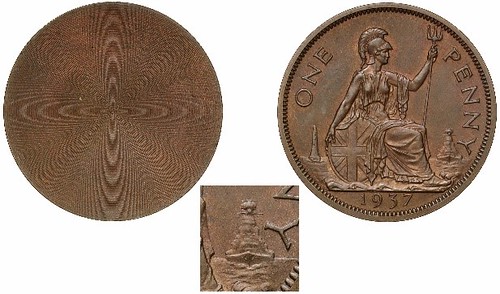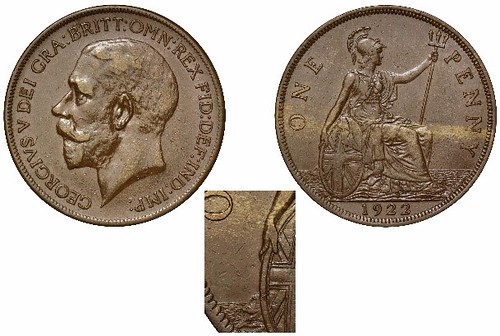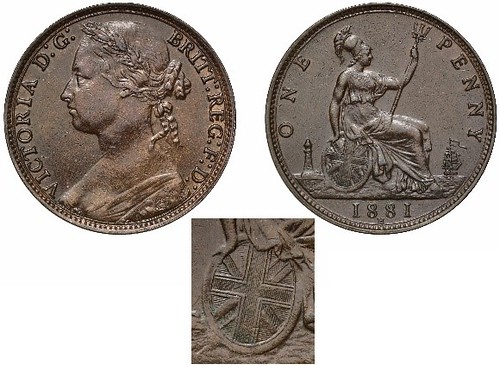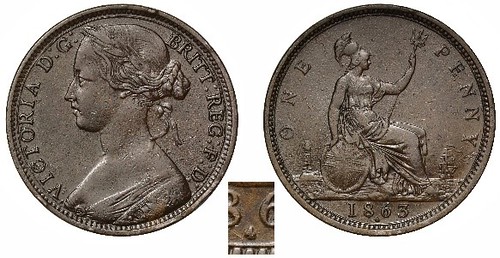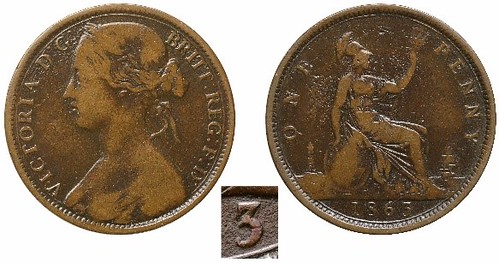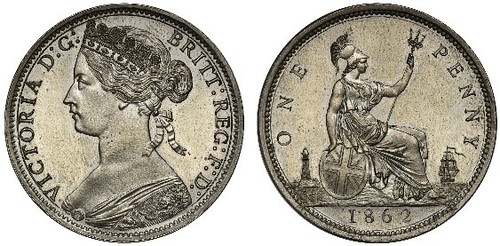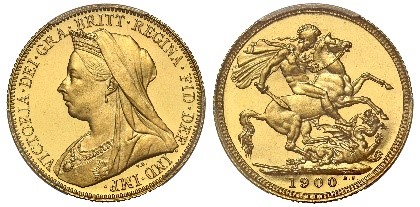
PREV ARTICLE
NEXT ARTICLE
FULL ISSUE
PREV FULL ISSUE
SOVEREIGN RARITIES WORKMAN COLLECTION, PART 2Here's an additional announcement from Sovereign Rarities with selections from the Bernard Workman Collection of Bronze Penny Rarities, and more. -Editor Sovereign Rarities of London UK are proud to present for auction on the afternoon of November 19th 2024 the Bernard Workman Collection of Bronze Penny Rarities 1860-1967 – a scintillating selection of forty of the most elusive pennies from the reigns of Queen Victoria to Queen Elizabeth II, including the only example in private ownership of the Edward VIII trial reverse with the modern dreadnought class battleship by Britannia that has never been auctioned before. With the advent of the reign of King Edward VIII the question of coinage was in gestation for a very long period from this modern thinking King, who wanted to revise nearly all the reverse designs on silver and bronze coinage, introduce a new twelve sided brass Threepence coin, and more controversially wished to face left on his coins like his Father, breaking a long held tradition since the time of the Stuarts for each succeeding monarch to face the opposite direction to their predecessor. However, a currency coinage never came to fruition due to the King abdicating for the love of the American divorcee Wallace Warfield-Simpson in December of 1936 (now a year of three Kings not seen since 1066) in favour of his younger brother who became King George VI (1936-52). Luckily for the delight of numismatists, there were some complete proof sets of coinage from gold Five Pounds to the bronze Farthing which do exist, one being held privately in the Tyrant collection, that show all the new designs that were modern for their time, including the Penny. The 1937 Proof Penny of Edward VIII has a design with the sea to the right of Britannia unhindered by any ship, and this adopted reverse design progresses unchanged into the reign of George VI for his proof set of 1937 and the ongoing currency. Before that and whilst the new proposed designs were in gestation during 1936, one of the more interesting earlier proposals for a Penny reverse design was this coin which depicts a modern armoured battleship sailing bow towards viewer, on the sea to right of Britannia. This proposed design with a battleship harks back to the Victorian bun head bronze pennies which feature a sailing cutter in this position, but presumably after consideration was eventually dropped as a proposal as this "Dreadnought" class of ship was an instrument of war having been used in World War I at what would have been a sensitive time in Germanic relations and the run up to World War II. This Pattern Penny although described as uniface in fact features a continuous linear spiral from centre to rim on the obverse side and is listed in Giordano's "Portraits of a Prince" publication on Edward VIII as one of two known. A plaster impression of this reverse is in the Royal Mint museum. This coin was purchased by Bernard Workman privately some ten years ago, his most recent purchase, and had been held in a private collection since the mid-1990s. It has never crossed the auction bloc before and is perhaps conservatively estimated at £10,000-£15,000 housed in an MS65BN NGC holder. Moving back to Edward VIII's Father George V we find this major coveted rarity, seemingly the finest known 1922 currency Penny that carries the later 1927 onward style reverse. This is a classic rarity in the George V series and apart from the unique 1954 and 1933 Pennies, is the rarest currency pre-decimal Penny of the 20th century. The obverse is the same as regular pennies of 1922 and before and it is the reverse that differs. There are a number of subtle differences but the most obvious to spot especially as most of the very rare survivors or in circulated worn state is where Britannia's hand grasps onto the shield. We see a different arrangement of finger and thumb compared to earlier pennies. The sea is also more finely cut in its ripple and wave detail, most noticeable to the right of Britannia. Graded by NGC as AU53 brown this coin is presumably the top of the population and maybe the only graded example with a straight grade, extremely rare this currency Penny is estimated to sell for £5,000-£6,000 on November 19th. This week we opened with the story of the battleship trial piece of Edward VIII, as we are on this maritime subject we must highlight this Pattern Penny which has a two masted sailing ship in full sail to the right of Britannia. The newer style "widow" head Pennies of Queen Victoria in an older phase of life were introduced as currency from 1893 with a veiled portrait facing left by Thomas Brock and we see a few alternative reverse designs being proposed for the following couple of years including this piece. Superbly rendered, the large sailing ship is quite dominating in the space to the right of Britannia, harking back to the earlier "bun head" design pennies that have a smaller sailing ship in the distance to the viewer. This larger ship was perhaps considered to overbearing to contemplate a change of design to currency and remains an extremely rare pattern piece hardly ever seen for sale and it has a wonderful provenance chain dating back to the Nobleman Collection in 1922. This is followed by the names Egmont Schmidt, C. Wilson Peck and Michael Freeman, the latter two being authors of their own standard works on the subject of these coinages. With a proof finish the coin has been graded by NGC as PF65 brown with an estimate of £6,000-£8,000 for November 19th 2024. In last week's E-Sylum we highlighted one of the Heaton mint Pennies of 1874 for auction on November 19th. For the year 1882 the vast majority of Bronze Pennies are usually also of the Heaton mint variety with the tiny letter H below the two 8s of the date. However, there are some extremely rare, usually low grade survivors of what must have been a very small London issue of 1882 dated pennies. These London mint issues also carry a different die combination to the Heaton pieces to prove their origin and are not determined just on the lack of the H mint mark. The London issue has a finer arrangement of border teeth than Heaton, a more hooked nose with a weaker bridge and some raised leaf veins in the 15 leaf wreath. The reverse has an overall thinner Britannia and a thinner trident shaft than the Heaton production, as well as the lack of mint mark. This coin definition wise is one of the best survivors of this London production and is toned, however NGC have deemed it to have been cleaned, but such a rarity will no doubt garner a lot of bids on the attractive estimate of only £2,000-£3,000 on November 19th. Going back one year we have the rarest Heaton Mint Penny of 1881 due to its die combination. Struck in Birmingham, this coin carries the H mint mark under the two 8s of the date and has been classified by Michael Freeman as number 103 which is obverse die 9 and reverse die M. This means the obverse has a 17 leaf laurel wreath with incuse veins and 6 berries, and the Queen has a more deeply engraved nostril. The reverse die has a heraldically shaded shield and a thicker lighthouse as well as the H mint mark below the date. The coin does have some light circulation weak with some surface marks and NGC in their wisdom have deemed this coin to be details cleaned. However with a Freeman rating of R19 out of 20 points for rarity it is estimated at £1,200-£1,800 for the November auction. In last week's E-Sylum we covered the 1863 die number Pennies of which numbers 2, 3, 4 and 5 are known, all with slim survival and here we feature the die number 4 piece with the tiny number below the 8 and 6 of the date. All part of an experiment to trace the use of the dies by an operator and subsequent output. Though the coin is toned with wear from circulation NGC have deemed it as cleaned but as such a rare survivor with this number 4 it is fairly estimated at £3,000-£4,000 for the 19th November auction. Seemingly the greatest currency rarity for the date 1863 is this Penny with a more slender thinner 3 in date than usual and still one of only two examples known, this being the first one discovered and once part of the Michael Freeman and H. Samuel collections where it only was offered as part of larger lot groups of pennies for sale. Once the second example was discovered in just as well circulated condition, that coin sold at a London auction 15 years ago for an amazing £19,000 hammer after a strenuous bidding battle on a much lower estimation. This coin in the Bernie Workman collection was purchased by him from the Samuel Collection in 1995 and is housed in a "environmental damage" NGC holder which is fair considering the overall preservation of this rare piece. The date variety is most clear and as one of two known estimated at £2,000-£3,000 for November 19th. For last week's E-Sylum we highlighted the cupro-nickel pattern of 1870 with the same design as this piece. This coin is one of five patterns all of the same design and is from the earliest date of 1862 and in the off metal of nickel brass. The obverse design was by T. J. Minton who took over as Resident Engraver in 1865 and was the last person to hold this post, after the previous holder George Wyon died in 1862. The design was modelled on a portrait by sculptor W. Theed who was a designer for Wedgewood. The coronet head obverse was not subsequently used on British coinage but a derivative was used on some colonial coinages for Malta, British Honduras and the Strait Settlements. This nickel brass piece is of the highest rarity, graded by NGC as PF65 and estimated to sell for £6,000-£8,000. There are also bronze versions of this pattern dated 1862, 1865 and 1870 in the Bernard Workman collection. The second of three overdate coins in the offering of Pennies from the Bernard Workman Collection is the finest graded 1861 with the 8 struck over a 6 in the date. With the grade so high as MS65 red and brown this coin is actually amongst the finest of the population of the regular date currency pennies, nevermind the fact it is the extremely rare overdate. Therefore on November 19th this coin is estimated to sell at £6,000-£8,000 Other Property: Aside from the Bernard Workman Collection of Pennies in the Sovereign Rarities Auction 16 of the 19th November there are some other great British coins as well as this highly valuable rarity struck from Australian gold at the Melbourne Mint in 1900. This superbly preserved gold Proof Sovereign of the year 1900 from Melbourne is thought to be one of only two examples that exist and is the only one graded. This coin has been through Australian auctions on at least four occasions dating back to the 1980s and is rumoured to have once been part of the A. H. F. Baldwin Collection and possibly J. G. Murdoch. The coin is a superb example of any proof Sovereign, and it is nice it features the turn of the century date. Estimated at £50,000-£60,000 it will be sold in the general part of our sale on the afternoon of 19th November.
For more information, see:
To read the earlier E-Sylum article, see:
Wayne Homren, Editor The Numismatic Bibliomania Society is a non-profit organization promoting numismatic literature. See our web site at coinbooks.org. To submit items for publication in The E-Sylum, write to the Editor at this address: whomren@gmail.com To subscribe go to: https://my.binhost.com/lists/listinfo/esylum All Rights Reserved. NBS Home Page Contact the NBS webmaster 
|
